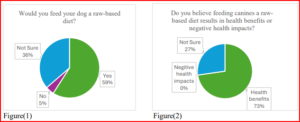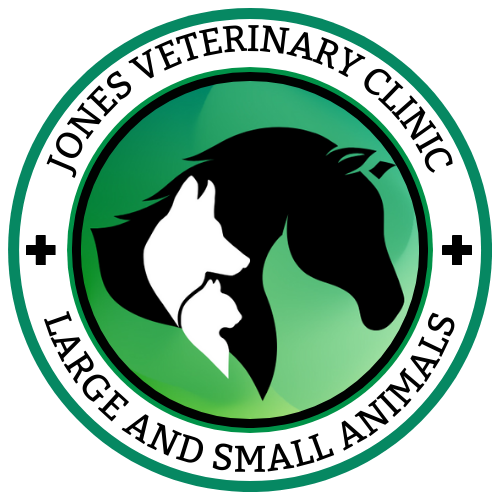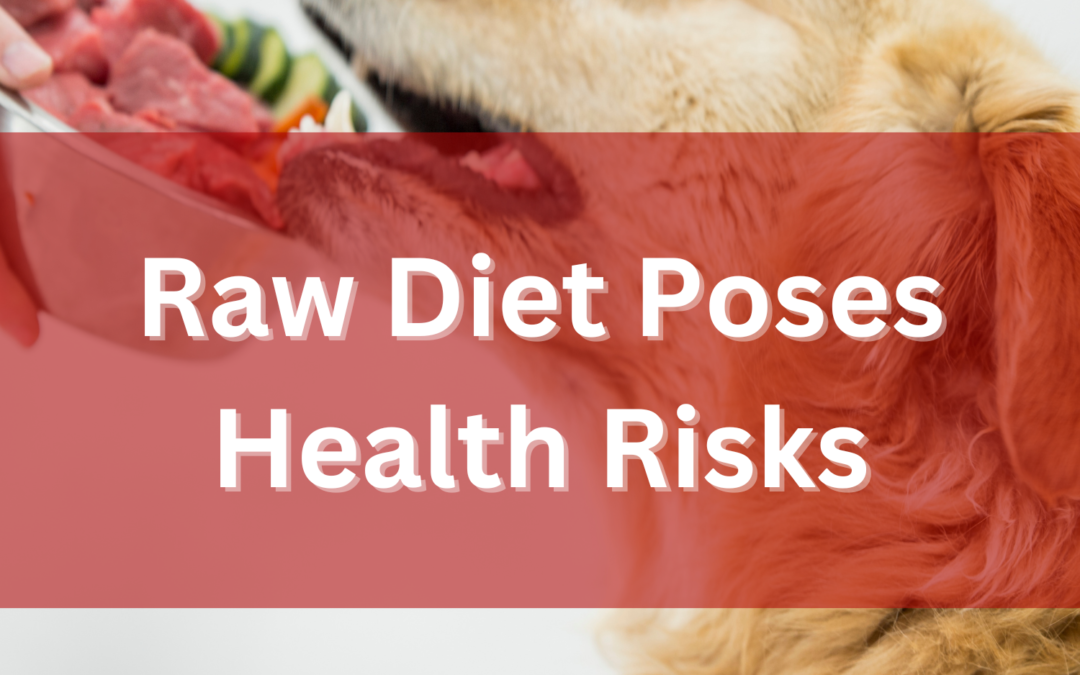Author of this study credited to: Gabrielle Leonard
Canine owners have numerous options when selecting a diet for their dogs. Within the last few years, the selection of raw-based diets has become extremely popular among dog owners. Raw-based diets typically consist of various raw meats such as poultry, beef, and pork with the addition of grains, vegetables, and dairy products. While this popular diet has been on the rise and has been implemented as a daily diet for many canine pets the diet has not been noted for its consistency. The topic being investigated asks the question- Does feeding a rawbased diet to domesticated canines put them at risk for negative health effects?
This investigation of the negative health impacts of raw-based diets contributes to owner education that may influence the decision-making process when contemplating their pet’s diet. Raw-based diets are moving up the ladder of popularity, investigating the overall safety of this diet as well as long-term and short-term nutritional effects will help canine owners decide if raw feeding qualifies as a safe option for their dogs’ diet. Common negative impacts of raw-based diets are unbalanced nutrients, GI obstructions, and antibiotic resistance to pathogens from raw meat. One of the common issues with raw feeding is the nutritional balance of the diet.
Unfortunately, there is currently no “gold-standard” protocol for a raw-based canine diet readily available to dog owners. A quick Google search on raw diets will take you down a rabbit hole of information, and the majority of it pushes owners meaning well to feed a heavily unbalanced diet. Furthermore, it is encouraged by veterinary staff that owners seek advice from a boardcertified veterinary nutritionist. Graduates of vet school are certified for general practice they then achieve further specialization through continued education typically involving on-the-job training under a specialist DVM. These veterinary nutritionists are well-versed in balancing home-cooked diets and in some cases raw-based diets. The findings of this study concluded that feeding a raw-based diet does put canines at significant risk of negative health impacts.
Literature Review
Veterinary technician Jessica dives into the difficulty of properly balancing a raw diet not necessarily because of the food portion but because of the nutritional misinformation. Jessica emphasizes that raw diet protocols are commonly offered to the public through nonprofessionals, stating her concern surrounding this as the misinformation surrounding balancing a raw diet is vast. Jessica provides her readers with an overview of the mechanical process of the canine GI tract, explaining how pathogens found in raw meats can survive the digestive process, therefore infecting the canine.
Josepha DeLay and co-author Laing cover a case involving a litter of puppies that were fed a raw diet upon weaning. The puppies all exhibited symptoms of malnutrition as well as weakening of limbs. Veterinarians performed necropsies on the puppies of this litter and found evidence of poorly developed bone tissue, as well as fractures due to extreme calcium deficiency caused by the raw diet. Canines fed a raw-based diet are most commonly noted for their physical impairments that are typically linked to the overall unbalanced aspect of feeding raw. These puppies were brought in to be examined under the complaint of “failure to thrive.” Given that these puppies were at a paramount point in structural and cognitive development it should be noted these defects were associated with poor nutritional intake.
A study completed by the Clinical Nutrition Team at Tufts University involving Lisa Freeman and colleagues heavily discusses the health concerns that arise by implementing a BARF (Bone and Raw Food) diet as a source of “nutrition” and debunk the myths that support the nutritional benefits of feeding a raw diet to canines. A few health concerns include nutrient deficiency or excessive intake, the possibility of swallowing bone or bone fragments leading to blockages that require intensive care and risky exploratory surgeries, and even overall ingestion of bacteria or high-fat content that is a known cause of inflammation in the gastrointestinal tract. It is important to note that not only are the canine companions at risk of bacteria pathogens causing extreme reactions, but the human family is as well. While caution can be used while food handling there are many variables required to eliminate a potential contamination and often will go unnoticed until a contamination leads to a hospital visit by either the pet or the owner. This not only gives the owner a difficult ultimatum of cost but also a risk that is not worth any of the false benefits claimed by these food companies. A price range for a canine exploratory in a rural Oklahoma town is roughly $1,500 for the basic care not including any post-surgical followups that will be required to ensure a full recovery.
Anton Martinez and a specialist with a veterinary background concluded in a study that there is a significant connection between acute polyradiculoneuritis (APN) and the pathogen campylobacter. APN is a nerve disorder that causes body paralysis, while campylobacter is a pathogen commonly found in raw food-grade poultry. The canines in this specific study were commonly fed raw chicken necks and bones that were infected with the pathogen and soon diagnosed with the aforementioned nerve disorder. The transmissions of bacteria can be not only through food and its handling but also through water and fecal-oral routes; thus, documenting another reason raw meat preparation hygiene is important for all parties involved in the care and handling of animal products. This study concluded a direct link between canines fed raw food grade chicken and the pathogen campylobacter, this shows the significant risk of pathogen contamination risk and exposure when feeding raw-based diets. By feeding a domesticated canine a raw diet the literature suggests we are essentially causing a negative effect over time to our four-legged friends. In the review of many case studies conducted by veterinarians and their associates, it is proven that the long-term negative effect is much greater than the benefits that an owner may feel they are seeing.
Methods
To further investigate the question- Does feeding a raw-based diet to domesticated canines put them at risk for negative health effects? I sent out a survey for my classmates to respond to and a survey for dog owners that I conducted in the PetSmart parking lot, to receive a layman’s opinion on the topic. I then sent the same survey to staff members at Ellis and Bellinger
Veterinary Clinic to receive a field experience-based opinion. Lastly, I went on to interview two DVM’s as well as one RVT, to receive a professional opinion.
Results
After reviewing a brief survey presented to classmates the majority ruled that they believed feeding their dog a raw diet was a safe option and resulted in health benefits. In the survey when asked where they would look for information to properly balance nutrients in a raw diet, 55.6% of students responded with Google. The other options presented to students were pet store, certified veterinary nutritionist, human nutritionist, or other. Results are listed below with the question details and responses shown in tables 1-4.
PetSmart Survey Responses

Figure(1) Figure(2)
Vet Clinic Staff Responses

Figure(3) Figure(4)
While comparing data between the two surveys it is noted that the participants in the PetSmart survey were more likely to consider feeding their dog a raw-based diet, while veterinary staff members were completely against feeding raw. Three of the PetSmart participants who selected health benefits in Fig(2) also admitted that they did not have any research to back up their answer but were heavily influenced by media and ads that feeding a raw-based diet had health benefits. The 15% represented in Fig(4) is a staff member who stated, “I picked not sure because I truly am unaware of negative or positive impacts of feeding raw, but have heard other members in the clinic strongly advise clients not to feed that particular diet.”
I was able to obtain an interview with Chris Bellinger, a certified DVM with twenty years of experience in the field. Bellinger has performed a vast number of “foreign body” operations which involved removing large pieces of bones and fragments from the GI tract that wound up there due to dog owners feeding a raw-based diet with large quantities of whole chicken with bones intact. Bellinger explained that he has seen multiple cases of salmonella and E. coli. contaminations as a result of feeding raw-based diets. Bellinger went on to say, “The overall cost of treating these contaminants can range from $200 on the cheap end to up to $1500-$2000, this is assuming the animal isn’t septic and can withstand treatment.” This interview confirmed a direct link between feeding a raw diet and a potential cause of GI obstruction and pathogen contamination from a first-hand account.
I interviewed, Abraham Aviles, a licensed DVM with 10 years of experience in veterinary medicine. When posed with the question, do you believe raw-based diets cause negative health impacts, Abraham immediately took a stance against feeding raw. Abraham admitted he had no personal cases that were directly linked to negative raw feeding impacts but has had canine patients who were on raw diets that always seemed to have a poor body score that he believed to be linked to poor nutrition. While this interview did not provide a direct correlation between negative health impacts and feeding raw the professional observation of poor body condition is worth noting.
Brandy Osburn, RVT graduate of OSU, OKC was interviewed to provide evidence of the negative health impacts of feeding a raw-based diet to canines. Brandy accounted for many safety concerns involving raw diets mostly revolving around pathogen risk and GI obstruction. Brandy could recall being present for many foreign body surgeries involving the removal of bone fragments and salmonella infection after being fed a raw diet. Brandy went on to say, “I would never recommend a raw diet to a client dog or consider it for my own, I have yet to see any credible research stating any positive health impacts but have seen first-hand negative impacts, as well as many studies and credible sources, advising to avoid raw-based diets at all cost.” Brandy went on to say that she believed many clients who do a simple Google search on rawbased diets are flooded with misinformation revolving around the subject and are heavily led to believe raw feeding is a healthy option. Brandy advised anyone looking to seek information on the subject to reach out to their veterinarian to obtain credible information on the matter. After speaking with Brandy it was clear that she felt strongly about the topic and felt a great need to advocate for her patients, as she has seen first-hand the negative implications of raw diets in canines.
Discussion
Based on my research and findings it can be concluded there is a direct link in feeding canines a raw-based diet poses a risk of negative health impacts. The research shows a heavy risk of pathogen contamination as well as GI obstruction risk, nutritional imbalances, and poor overall health impacts. I was faced with many limitations in this study one being unable to get in contact with a veterinary nutritionist. I believe much of this was due to brand association and not wanting to speak negatively against an employer, as well as conflicting schedules. To further research this topic interviews with veterinary nutritionists would be suggested as well as studies with a clear balanced raw diet protocol in place with health monitoring over a long duration of time. One of the common bases in the group of participants of the surveys was the belief that veterinary staff received incentives for purchases of dog foods they recommended to clients. To conclude each interview, I asked the question- have you at any point in your career received any form of compensation when a client purchased a dog food you recommended, all participants responded no.
Works Cited
DeLay, Josepha, and Jenny Laing. “Nutritional Osteodystrophy in Puppies Fed a BARF Diet.” AHL Newsletter, June 2002, p. Volume 6, Number 2, Pg 23.
Freeman, Lisa M., et al. “Raw Diets: A Healthy Choice or a Raw Deal?” Clinical Nutrition Service at Cummings School, 30 Sept. 2016, vetnutrition.tufts.edu/2016/01/raw-diets-ahealthy-choice-or-a-raw-deal/.
Jessica. “Why I Don’t Recommend Raw Diets.” Nutrition RVN, 11 Feb. 2024,
nutritionrvn.com/2024/01/14/top-5-reasons-i-dont-recommend-raw-diets/.
Martinez-Anton, L., et al. “Investigation of the Role of Campylobacter Infection in Suspected Acute Polyradiculoneuritis in Dogs.” Journal of Veterinary Internal Medicine, vol. 32, no. 1, Jan. 2018, pp. 352–60. https://doi.org/10.1111/jvim.15030.


